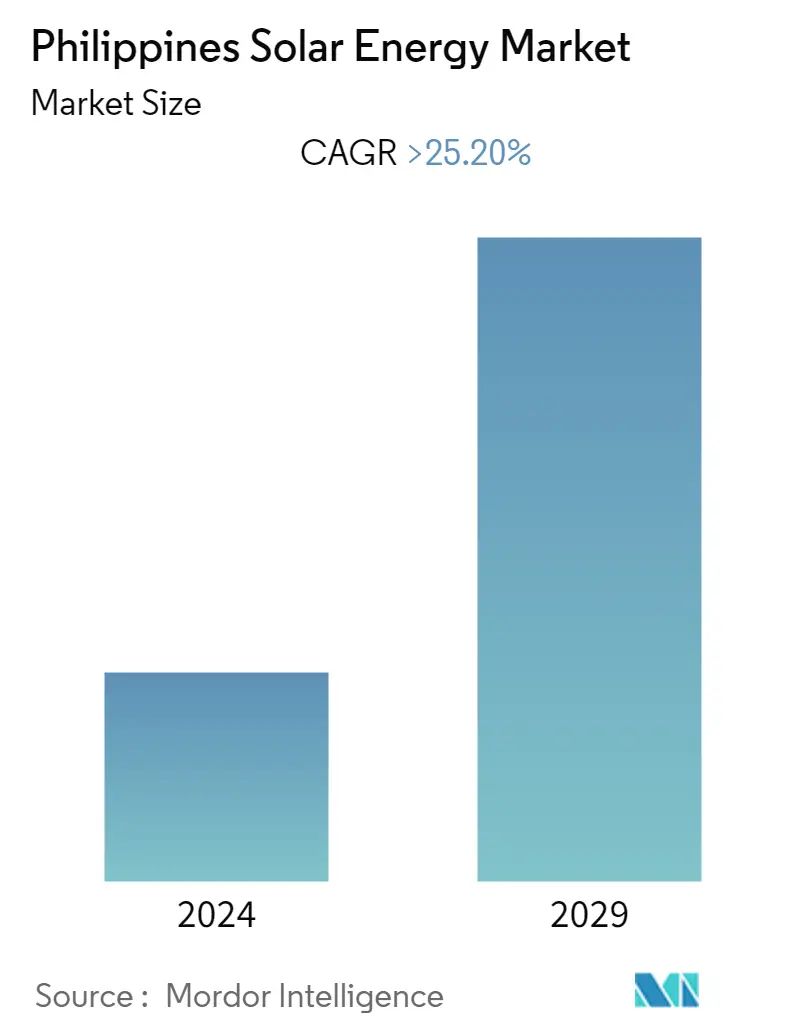Market Size of Philippines Solar Energy Industry

| Study Period | 2020 - 2029 |
| Base Year For Estimation | 2023 |
| Forecast Data Period | 2024 - 2029 |
| Historical Data Period | 2020 - 2022 |
| CAGR | 25.20 % |
| Market Concentration | Medium |
Major Players
*Disclaimer: Major Players sorted in no particular order |
Need a report that reflects how COVID-19 has impacted this market and its growth?
Philippines Solar Energy Market Analysis
The Philippines solar energy market is estimated to install 1700 Megawatt by the end of this year and is projected to reach 5229.62 Megawatt in the next five years, registering a CAGR of over 25.2% during the forecast period.
- Over the medium period, factors such as rapid economic development and a growing population are expected to drive the market during the forecast period. The growing demand for solar energy-based power generation and declining photovoltaic system prices are expected to drive the market during the forecast period.
- On the other hand, the country's inefficient electricity grid infrastructure is expected to hinder the market's growth in the coming years.
- Nevertheless, it is estimated that replacing/integrating diesel generators with renewable energy, like solar, can save the country over USD 200 million per year. Small islands in the Philippines are powered by generator-based mini-grids fueled by imported diesel and bunker (freighter) oil. These islands suffer from blackouts and unplanned power outages due to grid instability, inadequate generation capacity, and lack of subsidized fuel. Therefore, off-grid electrification through renewable energy sources, such as solar, is expected to create a significant opportunity in the future.
Philippines Solar Energy Industry Segmentation
Solar energy is heat and radiant light from the Sun that can be harnessed with technologies such as solar power (used to generate electricity) and solar thermal energy (used for applications such as water heating). The Philippines Solar Energy Market is segmented by technology. The market is segmented by technology into solar photovoltaic (PV) and concentrated solar power (CSP). The market sizing and forecasts for each segment have been done based on installed capacity (GW).
Philippines Solar Energy Market Size Summary
The solar energy market in the Philippines is poised for significant growth, driven by rapid economic development and an increasing population. The demand for solar energy-based power generation is on the rise, supported by declining costs of photovoltaic systems. This trend is expected to propel the market forward, despite challenges such as the country's inefficient electricity grid infrastructure. The potential for off-grid electrification through solar energy presents a substantial opportunity, particularly for small islands currently reliant on diesel-powered mini-grids. The integration of solar energy is anticipated to offer substantial savings by replacing diesel generators, addressing issues of blackouts and power outages caused by grid instability and inadequate generation capacity.
The solar photovoltaic (PV) segment is expected to dominate the market, fueled by the growing adoption of small-scale solar PV installations across residential, industrial, and commercial sectors. The Philippine Energy Plan aims to significantly increase the share of renewable energy in the country's power generation mix, further driving the deployment of solar PV systems. Despite some regulatory and financial hurdles limiting growth in certain sectors, the overall trend towards increased solar installations is supported by substantial cost reductions in solar technology. The market is moderately fragmented, with key players actively expanding their projects, such as large-scale solar farms and floating solar projects, which are set to enhance the country's solar energy capacity in the coming years.
Philippines Solar Energy Market Size - Table of Contents
-
1. MARKET OVERVIEW
-
1.1 Introduction
-
1.2 Evolution of Solar Power Market in the Philippines
-
1.3 Renewable Energy Mix, 2022
-
1.4 Solar Energy Installed Capacity and Forecast, in GW, till 2028
-
1.5 Recent Trends and Developments
-
1.6 Government Policies and Regulations
-
1.7 Market Dynamics
-
1.7.1 Drivers
-
1.7.1.1 The Growing Demand for Solar Energy-Based Power Generation
-
1.7.1.2 Declining Photovoltaic System Prices
-
-
1.7.2 Restraints
-
1.7.2.1 The Country's Inefficient Electricity Grid Infrastructure
-
-
-
1.8 PESTLE Analysis
-
-
2. MARKET SEGMENTATION - BY TECHNOLOGY
-
2.1 Solar Photovoltaic (PV)
-
2.2 Concentrated Solar Photovoltaic (CSP)
-
Philippines Solar Energy Market Size FAQs
What is the current Philippines Solar Energy Market size?
The Philippines Solar Energy Market is projected to register a CAGR of greater than 25.20% during the forecast period (2024-2029)
Who are the key players in Philippines Solar Energy Market?
Solar Philippines Power Project Holdings, Solenergy Systems Inc., Vena Energy, Solaric Corp. and Trina Solar Ltd are the major companies operating in the Philippines Solar Energy Market.

